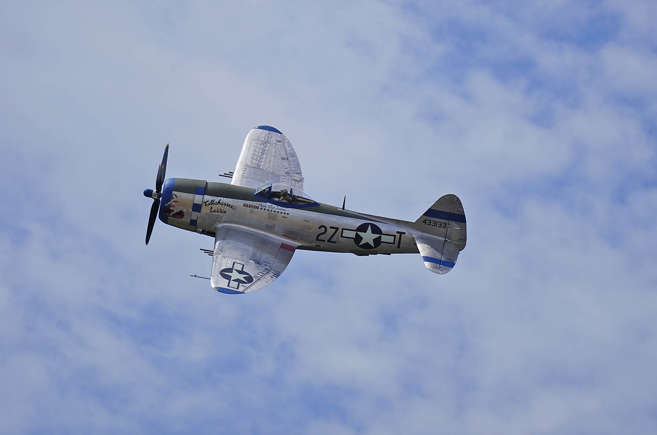
1. It Was One of the Largest and Heaviest Fighter Aircraft in WWII
Nicknamed the "Jug," short for "Juggernaut," the P-47 Thunderbolt was huge for a single-engine fighter. Weighing up to 17,500 pounds (fully loaded), it was larger than many twin-engine planes. Its bulk, however, didn't slow it down—thanks to a powerful Pratt & Whitney R-2800 Double Wasp radial engine producing over 2,000 horsepower.
This size and power combo made the P-47 ideal for high-altitude combat and low-level ground attacks, setting it apart from more agile but lighter fighters like the Spitfire or Bf 109.
2. The P-47 Excelled in Both Fighter and Ground Attack Roles
One of the Thunderbolt's defining traits was its versatility. Initially designed as a high-altitude escort fighter, it quickly proved to be a deadly ground-attack aircraft as well. Its eight .50 caliber machine guns, paired with bombs and rockets, made it one of the most feared aircraft by Axis ground forces.
Pilots often used the P-47 in "fighter-bomber" missions, destroying tanks, trains, convoys, and fortified positions across Europe and the Pacific.
3. It Had an Incredible Dive Speed and Durability
Few planes could match the P-47’s toughness. The Thunderbolt could dive at over 500 mph, allowing it to outpace enemy fighters in steep descents. It could also take immense damage and keep flying—pilots often returned to base with wings riddled with bullets, shot-out hydraulics, or even missing sections of fuselage.
This survivability saved countless lives and contributed to the aircraft's reputation among pilots as a “flying tank.”
4. The Thunderbolt Was a Key Player in D-Day and Beyond
In the lead-up to and aftermath of D-Day (June 6, 1944), the P-47 was a primary asset for close air support and air superiority over occupied France. Thunderbolts attacked German supply lines, troop concentrations, and communication hubs, crippling the enemy’s ability to respond to Allied advances.
Its ability to loiter over the battlefield and provide real-time support to ground troops helped shift the balance in the Allies’ favor.
5. The P-47 Was a Pilot Favorite for Its Power and Protection
Many American pilots swore by the Thunderbolt, praising its speed in a dive, robust construction, and lethal firepower. Unlike more fragile fighters, the P-47 gave pilots a sense of security, especially in ground attack roles where anti-aircraft fire was a constant threat.
Major Francis “Gabby” Gabreski, one of the top U.S. aces, flew the P-47 and scored 28 aerial victories, calling it a “beautiful machine.”
6. It Featured Advanced Technology for Its Time
The Thunderbolt was ahead of its time in many ways. It had turbo-supercharging, allowing it to maintain power at high altitudes—critical for bomber escort missions. It also came equipped with state-of-the-art radios and gunsights, making it a technological leader among WWII aircraft.
Later variants even featured bubble canopies for improved visibility and increased payload capacity.
7. Over 15,000 Units Were Built—A Testament to Its Success
The U.S. built 15,636 P-47 Thunderbolts between 1941 and 1945, making it the most produced American fighter of WWII. It served with distinction in both the European and Pacific Theaters, as well as with the air forces of Britain, France, Brazil, and the Soviet Union under the Lend-Lease program.
Its widespread use highlights its adaptability and effectiveness in varied combat environments.
8. It Was Replaced by the P-51 Mustang—but Not Because It Was Inferior
While the North American P-51 Mustang eventually took over long-range escort duties, this was largely due to the Mustang's superior range, not because it outperformed the Thunderbolt in other areas. In fact, in ground attack missions, many experts consider the P-47 superior due to its heavier armor and firepower.
Even as the Mustang gained fame, the Thunderbolt remained a workhorse until the end of the war.
9. The P-47 Left a Lasting Legacy in Aviation History
Today, the P-47 Thunderbolt is remembered not just as a fighter plane, but as a symbol of American air power during WWII. Dozens of P-47s survive in museums and private collections, some still flying in airshows around the world.
Its design influenced post-war aircraft, and its success proved the value of multi-role fighters in modern warfare.
Conclusion: Why the P-47 Thunderbolt Still Matters
The P-47 Thunderbolt wasn’t just a machine—it was a battlefield legend. From the skies over France to the jungles of the Pacific, it proved that power, resilience, and adaptability are just as important as speed and maneuverability in warfare.

You must be logged in to post a comment.